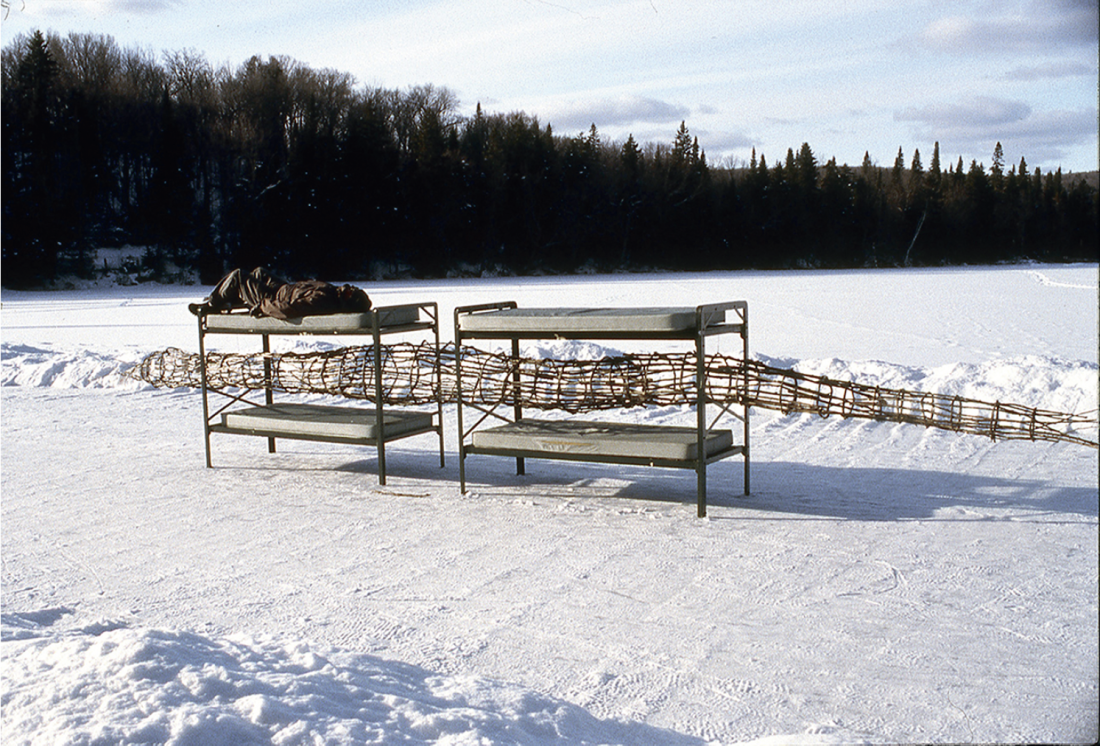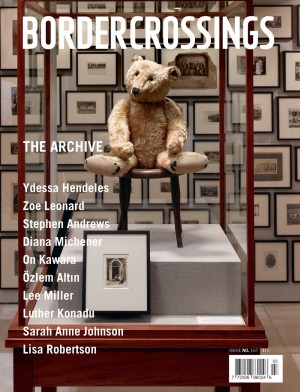“Exploration dans la mémoire de Boréal Art Nature”
Boréal Art Nature, established in Quebec in 1984, was probably the first arts organization in Canada devoted to environmental issues. The group’s members made work in natural, outdoor settings using local, mostly biodegradable materials and basic tools. Importantly, the group took on environmental issues while eschewing the traditional “white cube” gallery format.
Although Boréal did operate a gallery for a few years in its earlier life, its central activity was “expeditions.” Over the years, supported by modest private and but little public funding, the group visited rural locales in the Laurentians and on Canada’s west coast, and in other countries including Iceland and Wales and the Mexican state of Chiapas. In these places, Boréal members trekked into the wilderness, made camp and set about making art.
An exhibition at the Musée d’art contemporain des Laurentides, in Saint-Jérôme, Quebec, revisits this fascinating organization’s nine expeditions. The show is curated by former Boréal participant Richard Purdy, who kindly toured me through the exhibits.
Boréal’s composition shifted over time, but the “inner circle” included artists Jeane Fabb, Daniel Poulin (both pillars of the organization, active throughout its 25-year life), Lorraine Gilbert, Ginette Piché, Tedi Tafel, Julie Durocher and Luc Beauparlant. Later participants included Richard Purdy as well as François Morelli, Marlene Creates and quite a few others.
In this exhibition, each expedition receives its own display consisting of relevant photos, maps and various ephemera affixed to a large scrap of tarp or tent material—sometimes even from tents used in the expeditions. On one such support, cut from an old, white, heavily stained industrial prospector’s tent, a faint scent of old campfires is still evident.

Lorraine Gilbert, Terre rouge, 1999, from the “Sans traces” expedition, Iceland. Photo: Lorraine Gilbert. Courtesy Musée d’art contemporain des Laurentides, Saint-Jérôme.
One exhibit documenting a 1994 expedition to the Jumeaux Lakes, at La Minerve in the Laurentians, is titled “À l’affût” (on the lookout) and presented on a large piece of forest-patterned plastic tarp. Here we see various photographs of the group’s activities, including works by Fabb (an installation consisting of ornamented narrow tree trunks positioned in the forest), Piché (a circle of stones around a mossy area) and Beauparlant (a steel piece taken from a car and bent into a doorway, surrounded by a barrier of bunched sticks). Also present is a topographical map of the region, artistically adjusted to include a human profile and the outlines of hawks and geese. Crowning the display is an old, dark-green mosquito hood.
Boréal’s excursions sometimes involved collaborations with local groups. For example, a 2003 expedition titled “Crwydro” (Welsh for “wandering”) was carried out in the Preseli Hills of western Wales together with members of Ointment, a local art collective. Here, the two groups used a processbased approach, creating a tapestry across the land through the act of walking—“a great deal of walking,” according to Purdy. Two years later, Ointment members travelled to Quebec for a subsequent “return leg” expedition to the Laurentians called “Marcheurs des bois” (forest walkers).
Many Boréal works took shape as performances. In the “Marcheurs des bois” exhibit, for instance, a large photo depicts a simple, straight path through a snowy field. This path was the result of an hours-long performance by Julie Durocher that involved crossing an iced-over, snow-covered lake, walking back and forth in a straight line.
Purdy himself makes an appearance in the 1996 expedition “Forêt-frontière” (frontier forest) to Henderson Lake on Vancouver Island. In a large photo, the artist is seen perched on one leg upon a stone in a stream, body covered in blue dye from toe to eyebrows, in a performance Purdy describes as Buddhist-influenced.
That expedition, Purdy relates, visited lands (with permission) belonging to the Uchucklesaht First Nation. There, the Boréal artists observed clear-cutting being conducted on the lake’s opposite shore, and looked on as workers with chainsaws were flown in via helicopter—“ like in Apocalypse Now,” Purdy comments.
The nine expedition displays are complemented by four vitrines in the middle of the room showcasing an assortment of Boréal-related ephemera. These include publications such as catalogues and magazine articles but also artists’ sketchbooks, maps and compasses, a soup ladle (“we ate a lot of soup,” says Purdy), pocket knives, Jeane Fabb’s mosquito hat, work gloves and clothespins. Fabb, who died in 2013, maintained an extensive archive, and most of the materials on display are taken from there. She was the group’s main documenter, and many of the expedition photos are also hers.

François Morelli, Le somnambule, 2005, from the “Marcheurs des bois” expedition, Lac des sucreries, Quebec. Photo: unknown. Courtesy Musée d’art contemporain des Laurentides, Saint-Jérôme.
Described as a “laboratory-exhibition,” this is not a presentation of artworks so much as a snapshot of the life of an institution that carried on for a quarter-century. The aesthetics are often scrappy—and indeed, for a parallel the scrapbook is a rather good one. Photos of artworks are often paired with the artist’s name on a label stitched painstakingly to its corresponding tarp or tent. But other matters are left unexplained: no titles, no media or dimensions, no artist statements. The context provided for each item is mostly defined by the photos and other materials that surround it.
Perhaps the resulting picture is better for these omissions. Do we really need to know the title of each work or read a statement of each artist’s intentions? Do we need to see videos and listen in on headsets? The concerns of today’s art world—professional exhibition and archiving standards, academic theorizing, social media strategies, working with a grant proposal in mind—either did not exist or were not important for Boréal.
Indeed, the documentation here is sufficient to create a framework yet also to permit the imagination to fill in the gaps. It is like a photo album, a sharing of memories, which, as the exhibition essay states, tend to be “mythological and selective,” and concern impression as much as, if not more so, fact or detail.
The period between Boréal’s founding and today has seen vast change. For one thing, environmental issues, then still something of a fringe concern, are much better and more widely understood today (though insufficiently addressed). Artistic practices have also changed a great deal. Rejecting the typical gallery exhibition, Boréal’s approach was something of an outlier even at the time of its founding. Seen against today’s context, it seems positively alien.
A key effect of this exhibition, in this vein, is the overwhelming impression of how deeply satisfying it must have been to do art in this way. Forty years on, Boréal members’ practices seem naïve, idealistic, grubby, fun. If Boréal has relevance for us today, it is surely to remind us of what we have given away—and to imagine how we might recover it. ❚
“Exploration dans la mémoire de Boréal Art Nature” was exhibited at Musée d’art contemporain des Laurentides, Saint-Jérôme, from October 15, 2024, to January 19, 2025.
Edwin Janzen’s work has been published in Border Crossings, Canadian Art, Espace Art Actuel, Esse and other journals. Also a visual artist, Edwin keeps a studio in Montreal and works in drawing, collage, installation, digital printmaking and artist books.

